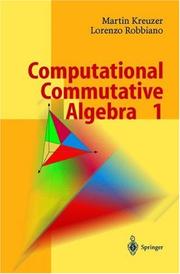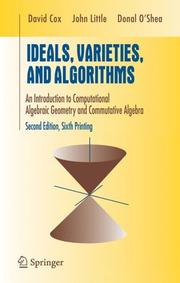| Listing 1 - 4 of 4 |
Sort by
|

ISBN: 354067733X 3540255273 3540706283 3642064914 3540282963 9783540677338 9783540255277 Year: 2005 Publisher: Berlin, Heidelberg : Springer Berlin Heidelberg : Imprint: Springer,
Abstract | Keywords | Export | Availability | Bookmark
 Loading...
Loading...Choose an application
- Reference Manager
- EndNote
- RefWorks (Direct export to RefWorks)
Computational Commutative Algebra 2 is the natural continuation of Computational Commutative Algebra 1 with some twists, starting with the differently coloured cover graphics. The first volume had 3 chapters, 20 sections, 44 tutorials, and some amusing quotes. Since bigger is better, this book contains 3 chapters filling almost twice as many pages, 23 sections (some as big as a whole chapter), and 55 tutorials (some as big as a whole section). The number of jokes and quotes has increased exponentially due to the little-known fact that a good mathematical joke is better than a dozen mediocre papers. The main part of this book is a breathtaking passeggiata through the computational domains of graded rings and modules and their Hilbert functions. Besides Gröbner bases, we encounter Hilbert bases, border bases, SAGBI bases, and even SuperG bases. The tutorials traverse areas ranging from algebraic geometry and combinatorics to photogrammetry, magic squares, coding theory, statistics, and automatic theorem proving. Whereas in the first volume gardening and chess playing were not treated, in this volume they are. This is a book for learning, teaching, reading, and most of all, enjoying the topic at hand. The theories it describes can be applied to anything from children's toys to oil production. If you buy it, probably one spot on your desk will be lost forever!
Gröbner bases --- Commutative algebra --- Grobner, Bases de --- Algebre commutative --- Data processing --- Informatique --- Commutative algebra -- Data processing. --- Gröbner bases. --- Gröbner basis theory --- Mathematics. --- Computer science --- Algebra. --- Algebraic geometry. --- Computer mathematics. --- Algorithms. --- Computational Mathematics and Numerical Analysis. --- Symbolic and Algebraic Manipulation. --- Algebraic Geometry. --- Data processing. --- Algebra --- Geometry, algebraic. --- Algebraic geometry --- Geometry --- Computer mathematics --- Discrete mathematics --- Electronic data processing --- Algorism --- Arithmetic --- Mathematics --- Mathematical analysis --- Foundations --- Combinatorial analysis. --- QA 150-272 Algebra. --- Computer science—Mathematics. --- Group theory. --- Group Theory and Generalizations. --- Groups, Theory of --- Substitutions (Mathematics) --- Commutative algebra - Data processing --- Algebre commutative - Informatique
Book
ISBN: 038797847X 354097847X 1475721838 1475721811 9780387978475 Year: 1992 Publisher: New York Springer
Abstract | Keywords | Export | Availability | Bookmark
 Loading...
Loading...Choose an application
- Reference Manager
- EndNote
- RefWorks (Direct export to RefWorks)
Algebraic geometry --- Computer. Automation --- Commutative algebra --- Geometry, Algebraic --- Algèbres commutatives --- Géométrie algébrique --- Data processing --- Informatique --- 512.77 --- -Geometry, Algebraic --- -#KVIV:BB --- Geometry --- Algebra --- Algebraic curves. Algebraic surfaces. Three-dimensional algebraic varieties --- Data processing. --- 512.77 Algebraic curves. Algebraic surfaces. Three-dimensional algebraic varieties --- #KVIV:BB --- Geometry, Algebraic - Data processing --- Commutative algebra - Data processing

ISBN: 0387946802 1475726953 1475726937 9780387946801 Year: 1997 Publisher: New York : Springer,
Abstract | Keywords | Export | Availability | Bookmark
 Loading...
Loading...Choose an application
- Reference Manager
- EndNote
- RefWorks (Direct export to RefWorks)
Algebraic Geometry is the study of systems of polynomial equations in one or more variables, asking such questions as: Does the system have finitely many solutions, and if so how can one find them? And if there are infinitely many solutions, how can they be described and manipulated? The solutions of a system of polynomial equations form a geometric object called a variety; the corresponding algebraic object is an ideal. There is a close relationship between ideals and varieties which reveals the intimate link between algebra and geometry. Written at a level appropriate to undergraduates, this book covers such topics as the Hilbert Basis Theorem, the Nullstellensatz, invariant theory, projective geometry, and dimension theory. The algorithms to answer questions such as those posed above are an important part of algebraic geometry. This book bases its discussion of algorithms on a generalization of the division algorithm for polynomials in one variable that was only discovered in the 1960's. Although the algorithmic roots of algebraic geometry are old, the computational aspects were neglected earlier in this century. This has changed in recent years, and new algorithms, coupled with the power of fast computers, have let to some interesting applications, for example in robotics and in geometric theorem proving. In preparing a new edition of Ideals, Varieties and Algorithms the authors present an improved proof of the Buchberger Criterion as well as a proof of Bezout's Theorem. Appendix C contains a new section on Axiom and an update about Maple , Mathematica and REDUCE.
Geometry, Algebraic --- Commutative algebra --- Data processing --- Algebraic geometry --- Algèbres commutatives --- Géométrie algébrique --- Algèbres commutatives --- Géométrie algébrique --- Computer. Automation --- Informatique --- Mathematical logic. --- Mathematical Logic and Foundations. --- Algebra of logic --- Logic, Universal --- Mathematical logic --- Symbolic and mathematical logic --- Symbolic logic --- Mathematics --- Algebra, Abstract --- Metamathematics --- Set theory --- Syllogism --- Geometry, Algebraic - Data processing --- Commutative algebra - Data processing --- Géométrie algébrique. --- Algorithms --- Algorithmes. --- Algèbres commutatives.
Book
ISSN: 01726056 ISBN: 9783319167213 3319167200 9783319167206 3319167219 Year: 2015 Publisher: Cham : Springer International Publishing : Imprint: Springer,
Abstract | Keywords | Export | Availability | Bookmark
 Loading...
Loading...Choose an application
- Reference Manager
- EndNote
- RefWorks (Direct export to RefWorks)
This text covers topics in algebraic geometry and commutative algebra with a strong perspective toward practical and computational aspects. The first four chapters form the core of the book. A comprehensive chart in the preface illustrates a variety of ways to proceed with the material once these chapters are covered. In addition to the fundamentals of algebraic geometry—the elimination theorem, the extension theorem, the closure theorem, and the Nullstellensatz—this new edition incorporates several substantial changes, all of which are listed in the Preface. The largest revision incorporates a new chapter (ten), which presents some of the essentials of progress made over the last decades in computing Gröbner bases. The book also includes current computer algebra material in Appendix C and updated independent projects (Appendix D). The book may serve as a first or second course in undergraduate abstract algebra and, with some supplementation perhaps, for beginning graduate level courses in algebraic geometry or computational algebra. Prerequisites for the reader include linear algebra and a proof-oriented course. It is assumed that the reader has access to a computer algebra system. Appendix C describes features of Maple™, Mathematica®, and Sage, as well as other systems that are most relevant to the text. Pseudocode is used in the text; Appendix B carefully describes the pseudocode used. From the reviews of previous editions: “…The book gives an introduction to Buchberger’s algorithm with applications to syzygies, Hilbert polynomials, primary decompositions. There is an introduction to classical algebraic geometry with applications to the ideal membership problem, solving polynomial equations, and elimination theory. …The book is well-written. …The reviewer is sure that it will be an excellent guide to introduce further undergraduates in the algorithmic aspect of commutative algebra and algebraic geometry.” —Peter Schenzel, zbMATH, 2007 “I consider the book to be wonderful. ... The exposition is very clear, there are many helpful pictures, and there are a great many instructive exercises, some quite challenging ... offers the heart and soul of modern commutative and algebraic geometry.” —The American Mathematical Monthly.
Mathematics. --- Algebraic Geometry. --- Commutative Rings and Algebras. --- Mathematical Logic and Foundations. --- Mathematical Software. --- Geometry, algebraic. --- Algebra. --- Computer software. --- Logic, Symbolic and mathematical. --- Mathématiques --- Algèbre --- Logiciels --- Logique symbolique et mathématique --- Mathematics --- Physical Sciences & Mathematics --- Geometry --- Algebraic geometry. --- Commutative algebra. --- Commutative rings. --- Mathematical logic. --- Geometry, Algebraic --- Commutative algebra --- Data processing --- Algebra of logic --- Logic, Universal --- Mathematical logic --- Symbolic and mathematical logic --- Symbolic logic --- Algebra, Abstract --- Metamathematics --- Set theory --- Syllogism --- Mathematical analysis --- Algebraic geometry --- Software, Computer --- Computer systems --- Data processing. --- Rings (Algebra) --- Algebra --- Ordered algebraic structures --- Mathematical control systems --- Computer architecture. Operating systems --- Computer. Automation --- Geometry, Algebraic - Data processing --- Commutative algebra - Data processing
| Listing 1 - 4 of 4 |
Sort by
|

 Search
Search Feedback
Feedback About
About Help
Help News
News